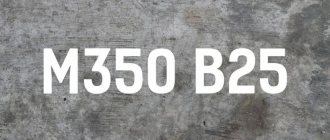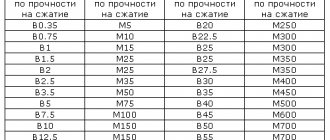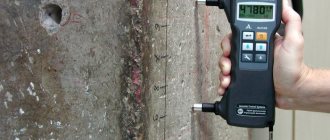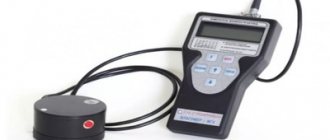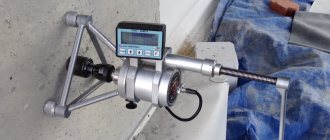It is mandatory to check the quality of the material used during the installation of buildings and structures. To confirm compliance of the declared characteristics with design standards, concrete is tested for strength, bending and tensile strength. This measure allows the contractor to report to the customer on the work carried out in accordance with the project, and the manufacturer to confirm the quality of the products. Timely tests will allow you to make changes to the progress of work and avoid mistakes.
Tests are carried out in certified laboratories based on GOST 22690-2015, for which specialists use various methods of measuring and influencing selected material samples. They usually use concrete cubes that are tested under compression, but there are other research methods.
During the test, the following results are obtained:
- Determine the compliance of the quality of the material with the design documents. Tests are carried out at least three times during the entire construction period.
- If the characteristics deviate, structures made from rejected material are replaced, which allows the overall performance of the structure to be maintained within the project.
- Preliminary tests are mandatory when carrying out repair work in technical rooms and basements.
- Testing of reinforced concrete structures makes it possible to make decisions about the fate of old buildings and structures.
What does the strength of concrete depend on and what influences it?
The ability of concrete to resist external influences due to internal stress depends on the composition of the solution and the brand of cement. When confirming the strength of a material corresponding to a certain brand, the sample should not show signs of destruction in the form of chips, cracks, or delamination of the structure.
Sometimes builders, when carrying out work, try to save on materials by using cheaper, low-grade concrete, but violating the design values can lead to serious consequences, so such a means of saving is unacceptable.
In addition to the ratio of filler and cement, the strength of the composition is influenced by additives and plasticizers used to give the product special properties (acid resistance, water resistance, speed of rise, plasticity). To obtain structures that can withstand high loads, it is mandatory to reinforce the elements with metal wire of various sections.
In addition to the composition of the solution, the strength of concrete is influenced by the external conditions under which the pouring is carried out. With high-quality removal of air bubbles from the concrete mass by compacting the mixture, the strength of the products increases noticeably.
It should also be taken into account that when using a solution at subzero temperatures, measures should be taken to heat the material by installing electrodes in the fill and connecting electricity to them. In such a situation, covering the base with sawdust is also used.
When working with concrete, it is important to maintain the necessary humidity to prevent cracking of the pouring surface due to rapid evaporation of moisture, which also affects the quality of the material and its strength. To avoid this process, it is necessary to cover the concrete with film or other available means, and also periodically moisten the surface.
As a result, it can be argued that the strength of concrete depends on many factors, and therefore quality control is especially important when installing load-bearing structures, since even if the technological processes are fully followed, there can always be factors that will affect the concrete and cause problems in the future .
Procedure for testing a concrete cube
- Remove the sample from the water after the specified curing time and wipe off excess water from the surface.
- Clean the surface of the testing machine
- Place the sample in the machine so that the load is applied to opposite sides of the cast cube.
- Center the sample on the machine base plate.
- Gently rotate the moving part by hand until it touches the top surface of the sample.
- Apply the load gradually, without impact and continuously, at a rate of 140 kg/cm2/min until the specimen fails
- Record the maximum load and note any unusual features at failure.
Notes:
A minimum of three samples must be tested at each set age selected.
If the strength of any sample varies by more than 15 percent of the average strength, the results of such testing should be considered invalid. The average of three samples gives the crushing strength of concrete. And shows compliance with the requirements for concrete strength.
Classification of test methods
Several methods are used to test concrete:
- Testing of samples cast in laboratory conditions. This method involves the production of cubes or cylinders from the test mixture, followed by testing the strength of the material on a press;
- Checking samples cut or cut from a finished structure. Such samples are obtained by drilling with diamond bits. Next, the resulting cores are sent to the laboratory to determine the strength characteristics, as in the first case, using a press. This method is associated with significant costs in obtaining the sample and with the threat of weakening the integrity of the element from which the core was obtained;
- A method for testing concrete for strength using a non-destructive method. In this case, tools and devices are used with which you can study the characteristics of concrete without placing samples in special devices. For these studies, ultrasound can be used, the quality of the base can be checked using the shock-impulse concrete testing method, etc.
The most popular method, which allows one to obtain the most accurate indicators of the properties of concrete, is testing samples for compression under pressure.
Acceptable options for control samples.
Procedure for testing the strength of concrete cubes
You will need:
Compression Testing Machine Test Laboratory Press
Preparation of a specific cubic sample
The proportion and material used to make these test specimens are from the same concrete used in the construction of the facility in the field.
Sample for making concrete cubes
Need 6 samples of cubes 15 * 15 cm
Mixing concrete for cube testing
Mix concrete by hand or in a laboratory mixer
Manual mixing
- Mix the cement and fine aggregate on a waterproof, non-absorbent platform until the mixture is thoroughly mixed and uniform in color.
- Add coarse aggregate and mix with cement and fine aggregate until coarse aggregate is evenly distributed throughout the batch.
- Add water and mix until the concrete is smooth and reaches the desired consistency.
Preparing cubes for dough
- Clean the bumps and apply oil
- Pour concrete into the molds in layers about 5 cm thick.
- Compact each layer using at least 35 blows per layer using a tamping tool
- Level the top surface, level it with a spatula
Test specimens are stored in humid air for 24 hours and after this period the specimens are marked, removed from the molds and stored in clean fresh water until removed for testing.
Test stages
Concrete testing is carried out by examining samples for strength using non-destructive and destructive methods.
Destructive methods
This method involves testing using a press, when gradually increasing pressure is applied to a sample obtained during laboratory casting or cut from the base of a finished structure. The impact continues until the destruction of the sample is detected.
This method is the most accurate and mandatory when carrying out work on the construction of critical structures.
Non-destructive methods
To obtain results when using non-destructive testing methods, special instruments and devices are used. Partial destruction is carried out by fixing a special tool on the concrete surface, which allows you to examine the concrete for tearing, recording the required force.
The reaction of the material to shearing is also studied when the device is installed on the corner of a concrete base and the material is destroyed under load.
Separation with chipping.
Under shock loads, the behavior of concrete during impact is studied with a special device and the reaction to elastic rebound is recorded - the value of the rebound of a metal ball released with a certain force is measured.
During ultrasonic quality control of concrete, a special device is used that makes it possible to record the passage of waves inside the structure. Based on the reaction to reflection, a conclusion is drawn about the quality of the material.
Sclerometer.
How to test the strength of concrete yourself? It is impossible to obtain a complete study of the material at home. Quality control of the material can be done exclusively by visual methods. A high-quality mixture usually has a gray or gray-green color; the structure of the solution should be uniform, with normal viscosity.
If the material has a yellowish tint, this means that the quality of such a solution is low and its composition contains impurities that reduce the strength characteristics. A good sign is the discovery of a thick consistency of cement laitance on the surface of the solution.
Under impact loads (hitting a material that has gained full strength with a hammer), the tool should bounce off the base without significant changes on the surface, leaving almost invisible dents.
Types of concrete research
In addition to the basic testing methods, additional types of concrete testing are used:
- Cone draft
. This technique allows you to study the properties of the prepared solution. It is poured into a metal cone. After the cone is formed, it is taken out and the consistency, uniformity, fluidity and other indicators that affect the structure and strength of concrete are examined. - Compaction study
. The compaction coefficient of the finished solution is determined. The test is carried out in an apparatus with two containers equipped with funnels. Through the valve, the solution from the container filled with it is released into the second vessel, from where it enters the measuring cylinder. - Definition of plasticity and shape change
. To study these parameters of the solution, it is first poured into a special cone, from which it is served on the table by tilting the mold. This is how the spreading parameters of the material are determined. - Detection of air inclusions (pores)
. The test can be carried out in two ways. The first option is based on measuring the weight of a sample from a solution before and after intense shaking in a special installation. Another method involves squeezing the sample using a press.
When independently preparing the solution and pouring a concrete structure, simple indirect methods are often used. The strength of concrete can be assessed by color, since high-quality concrete has a greenish-gray color, and the greener the better. A yellowish tint indicates a decrease in quality. Proper quality is indicated by the appearance of cement laitance on the surface of the concrete pour, and it must be as thick as possible. Separate fractions of filler should not stand out on the surface of the poured mass. Finally, the hardened monolith can be lightly struck with a hammer. It will bounce off good concrete with a ringing sound, and only a small dent will remain on the surface.
Tensile test procedure
To perform tensile tests, you will need to prepare a sample of an elongated prism-type shape. This sample is placed in a special device in a horizontal position, then a force is applied to the middle of the sample with increasing load. The step of the impact on the sample is 0.5 MPa/s.
The result is recorded after the destruction of the concrete structure in the central part of the sample.
Compression test procedure
This test method allows you to determine the grade of the material. To carry out the test, cubes are cast from concrete used in construction, or samples are cut out from an already cast product. The size of concrete testing cubes varies from 100 to 300 mm along the edge. In addition to the cubic shape, samples can be made in the form of cylinders or prisms.
When casting samples in laboratory conditions, a vibrating table is used to ensure that the mixture obtains maximum density. Tests are carried out on days 3, 7 and 28 after the sample acquires strength. The main tests are carried out on the 28th day after the material has fully gained strength.
The sample is placed under a press, which presses on the cube with a power of 140 kgf/m2 in increments of 3.5 kgf/m2. The force vector is strictly perpendicular to the base of the sample. Based on the readings, the material’s ability to resist compression is determined, and the grade of concrete is recorded in the test report.
Sample test report.
Concrete testing methods
Concrete as a building material is tested in both hardened and unhardened states. However, the objectives of the tests are different. In the first case, the strength and other operational characteristics of the solid material are determined, and in the second case, its technological indicators are determined: workability, compactability, plasticity and the presence of air.
In addition, a distinction is made between non-destructive and destructive testing methods. Let's consider the types of tests of concrete mortar during the “course” of its use - before setting and gaining strength and after setting and gaining grade strength.
Concrete strength grades and their scope of application
To determine the characteristics of concrete, it is given a marking according to GOST: the letter M and a number indicating the compressive strength of the material. The higher the value, the more durable the product made from this material is - the strength depends on the amount of cement in the mixture.
According to its strength characteristics, concrete is divided into grades from M100 to M500 in increments of 50. Another characteristic, the concrete class, determines the ability of the material to work in aggressive environments.
Concrete grades M100, M150, M200 and M250 are classified as light and cellular. They are used for pouring structures that do not bear a significant load. They are used for constructing curbs, foundations for small buildings, and pedestrian paths.
Concrete M300 and M350 can be used for casting floor slabs, constructing foundations in multi-story construction, and casting monolithic walls.
The most durable concrete grades, M400, M450 and M500, are used in the production of reinforced concrete structures operating in difficult conditions with increased load (for example, for the construction of hydraulic structures).




